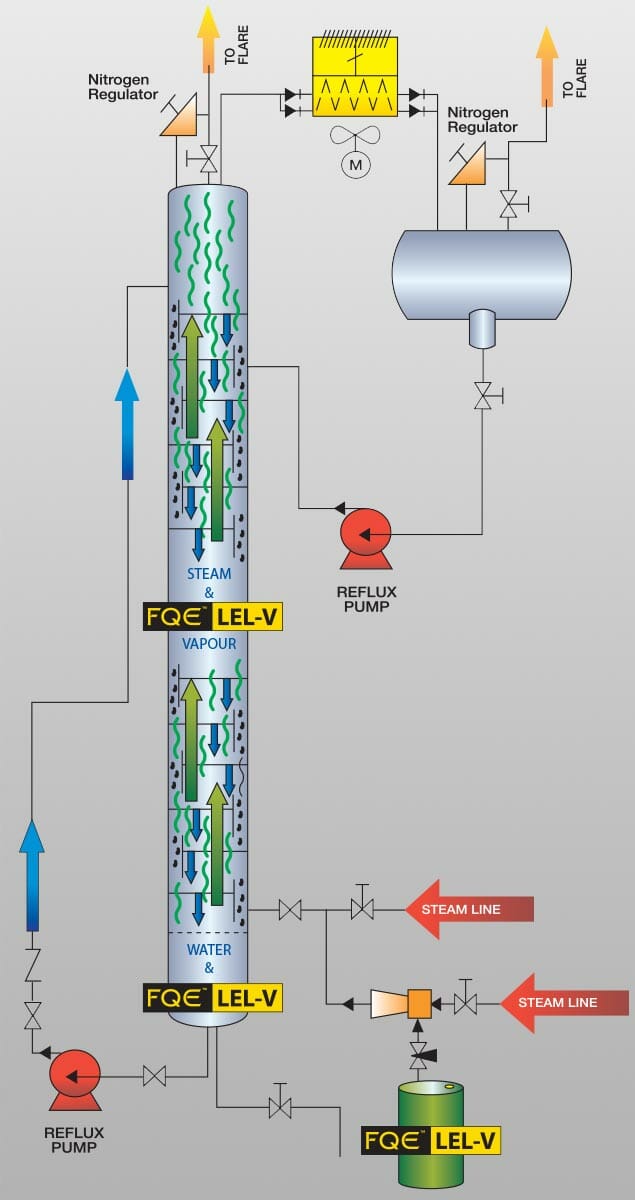Improved safety regulations, mandatory vessel inspections, and new environmental requirements are increasing the demand for system decontamination in the oil and gas industry.
In the past, system decontamination involved a lengthy steaming process that was applied until the contaminant levels dropped under the required values. This process was both expensive and inefficient, consuming a significant amount of time and steam. Vapour phase cleaning is an enhanced steaming method used to speed up the decontamination process. It works by injecting a small amount of chemicals (usually less than 1%) into the steam Vapour just before it enters the system. The specialized chemicals accelerate the cleaning process, target specific contaminants, and reduce overall cleaning time by as much as 60% to 70%.
Vapour phase cleaning can be used with most types of process equipment, including: reactors, columns, vessels (in general), heat exchangers, compressors, storage tanks, filters, piping, etc., and is effective in decontaminating main contaminants, such as: hydrocarbons (LEL’s, Benzene), hydrogen sulfide (H2S), pyrophoric iron (FeS), ammonia (NH3), and mercaptans
Vapour Phase Cleaning Process
The Vapour phase process has been designed to remove light deposits throughout contaminated systems; it will not remove heavy hydrocarbon deposits (e.g., bitumen, asphalt, wax). Such heavy deposits require liquid solvent flushes prior to vapour phase cleaning. In the presence of heavy sludge, some of the contaminants might reoccur in the system upon completion of the cleaning. The light compounds will migrate through the sludge and back into the decontaminated area. A solvent flush combined with Vapour phase cleaning is highly effective in decontaminating these systems.
Vapour phase cleaning requires a saturated steam supply and specific cleaning agents to perform an efficient cleaning cycle. To establish a flow of chemicals throughout the vessel, it is essential to connect the top of the vessel (or unit being cleaned) to the flare line to ensure that aggressive contaminants are not released into the atmosphere before being incinerated. The best location to inject steam into a vessel is in its lower portion, and some vessels may require multiple injection points to improve or speed up the cleaning process. This is based on the number of trays or packings inside the vessel. Chemicals are injected into the steam upstream of the vessel entry point. They are then carried by the steam throughout the vessel. However, due to metal thermodynamic properties, steam tends to condense on metal surfaces inside the vessel with the chemicals. The chemicals carried further by the steam condensate react with deposits on the wetted metal surfaces inside the system. The reaction products then flow down to the bottom of the vessel toward a drain system. To improve cleaning performance, it is important to collect all condensed waste and drain it out of the vessel. This can be done using either a closed drain system or a vacuum unit equipped with a Vapour scrubber unit connected to the bottom of the system.
To ensure effective cleaning throughout the system, part of the chemistry should be carried out through the top of the system in Vapour form and part should condense down the system walls. This crucial step of Vapour phase cleaning is controlled by making sure the temperature of the system is kept within the optimal range prior to and during chemical injection.
To ensure system cleanliness, emissions may be monitored by taking gas samples at system vents or monitoring liquid samples at drain points.
Vapour phase cleaning is typically completed in three phases:
- System preheating (heat the entire system to a temperature between 190°F and 210°F)
- Chemical injection (Vapour phase cleaning)
- Rinsing out the chemistry
Benefits of Vapour Phase Cleaning
Vapour phase cleaning has several advantages over conventional chemical cleaning:
- The time required to prepare process equipment for hot work or inspection is reduced significantly (over 60%), translating to lower maintenance costs and decreased system downtime.
- Vapour phase cleaning procedures and resources are both reliable and predictable, making it easier to schedule work with high accuracy and eliminating the risk of extended project schedules.
- Vapour phase cleaning requires less energy to maintain Vapour phase temperature than liquid phase temperature.
- Vapour phase cleaning increases the production efficiency of equipment, and therefore increases equipment lifespan.
- Vapour phase cleaning uses significantly lower amounts of chemicals, resulting in significantly less waste generated.
- The chemicals used in Vapour phase cleaning are biodegradable and therefore easy to handle, with no negative environmental footprint left behind.
